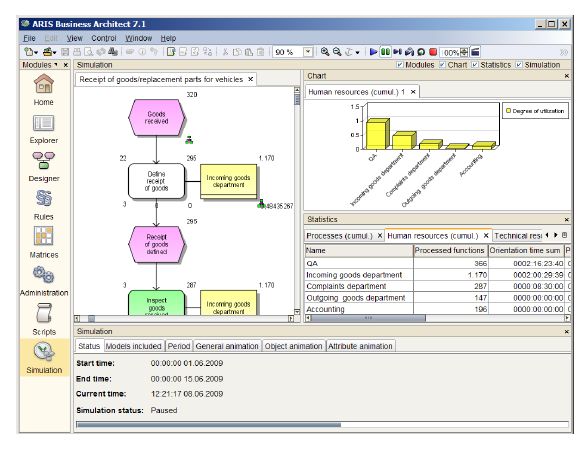 Business Process Simulation
Business Process Simulation
Business process simulation is an instrument for the analysis of business processes. It is used to assess the dynamic behavior of processes over time, i.e. the development of process and resource performance in reaction to changes or fluctuations of certain environment or system parameters. The results provide insights supporting decisions in process design or resource provision with the goal to improve factors such as process performance, process and product quality, customer satisfaction or resource utilization.
Definition of Input for Business Process Simulation
The input for business process simulation, the simulation model, typically comprises information about process flow, resources and process instantiation.
The process flow defines the time-based and logical order of function execution. Further information is added in order to define the behavior of decision points or loops in the flow during simulation. In addition the time spent for the execution of each function is specified.
One of the limiting factors in process execution is the availability of human and technical resources required to carry out the functions in a process. For these resources an assignment to functions is made and it is defined how many are required and provided. Depending on the sophistication of the business process simulation, additional information can be given, like times of availability, failure rates or skills and capabilities.
Process instantiation patterns define when and how often a process is triggered. They represent the occurrence of events which trigger a process or the demand for process execution, e.g. by customers. Process instantiators might also assign properties to process instances which are relevant for decision making further down in process flow.
Execution of Simulation Experiments
With the input defined, simulation experiments can be conducted. These experiments can involve the change of model parameters or the model itself in order to test various process and environment scenarios. Results are usually gathered and saved per scenario and simulation run for analysis purposes. The selection of results to be gathered depends on the analysis goals.
Analysis of Business Process Simulation Results
The results of business process simulation comprise quantitative, time-based and cost-related information about process execution and resource usage, e.g. waiting times, throughput times, completed process instances, resource utilization or cost per instance. This data can be aggregated for the different model objects but also given per instance. For the analysis it can be interesting to evaluate the data at a certain point in time, e.g. the number of completed process instances at the end of the simulation time, or over time, e.g. the development of waiting times after a peak in demand. The specific type of data to be generated by simulation and how it is analyzed depends on the analysis goal.
Business Process Simulation & ARIS
The following image shows ARIS Business Simulator as an example of a tool for business process simulation. The screenshot demonstrates the simulation of an EPC. In the model view on the left side the process flow with events and functions as well as the assignment of resources is visible. On the right side the results of simulation are presented in the form of tables and charts.

